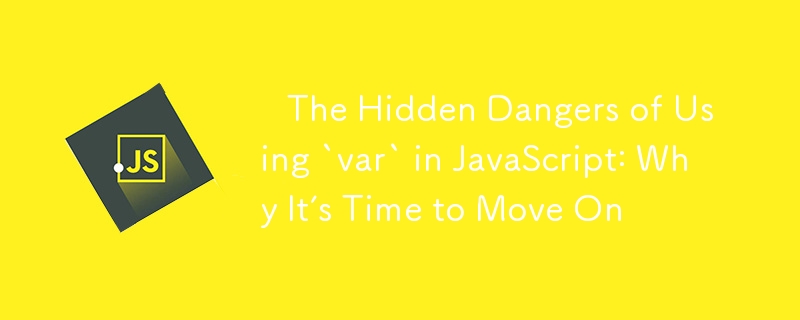
關鍵字 var 多年來一直是 JavaScript 中宣告變數的預設方式。但是,它有一些怪癖和陷阱,可能會導致程式碼出現意外行為。現代替代方案(如 let 和 const)解決了許多此類問題,使它們成為大多數情況下聲明變數的首選。
?說明:
在 JavaScript 中,var 宣告會提升到其作用域的頂部,這意味著即使宣告稍後出現在程式碼中,它們也會被初始化為未定義。這可能會導致令人困惑的行為並導致難以檢測的錯誤。
?重點:
?例:
console.log(myVar); // undefined (hoisted but not initialized) var myVar = 10; console.log(myVar); // 10
?註: 變數 myVar 被提升到作用域的頂部,但最初是未定義的,這可能會導致程式碼混亂。
?修復:
?修復範例:
console.log(myLet); // ReferenceError: myLet is not defined let myLet = 10; console.log(myLet); // 10
?評論: 使用 let 可以防止變數在聲明之前被訪問,從而減少混亂和潛在的錯誤。
?說明:
var 的主要缺陷之一是它是函數作用域,而不是區塊作用域。這意味著在循環、if 語句或其他區塊內聲明的變數不限於該區塊,而是可以在其外部訪問,這可能會導致錯誤。
?重點:
?例:
if (true) {
var blockVar = "I’m accessible outside this block";
}
console.log(blockVar); // "I’m accessible outside this block"
?註: 雖然 blockVar 是在 if 區塊內聲明的,但它仍然可以在區塊外訪問,因為 var 是函數作用域,而不是區塊作用域。
?修復:
?修復範例:
if (true) {
let blockLet = "I’m only accessible inside this block";
}
console.log(blockLet); // ReferenceError: blockLet is not defined
?註: 使用 let 或 const 可確保變數保持在各自的區塊內,防止作用域洩漏。
?說明:
使用 var,您可能會意外地在同一作用域中重新宣告相同變量,這可能會覆寫先前的值。這可能會導致無意的錯誤,尤其是在較大的程式碼庫中,變數名稱可能會被錯誤地重複使用。
?重點:
?例:
var name = "Alice"; var name = "Bob"; // No error, overwrites the previous value console.log(name); // "Bob"
?評論: 第二個名稱聲明會覆寫第一個名稱,可能會導致程式碼中出現錯誤。
?修復:
?修復範例:
let name = "Alice"; let name = "Bob"; // SyntaxError: Identifier 'name' has already been declared
?評論: 使用 let 或 const 可以幫助您避免重新聲明變數並確保您的程式碼保持可預測性。
?說明:
在循環中使用 var 時,變數的值可能會以意想不到的方式更改,尤其是在使用非同步程式碼時。由於 var 是函數作用域而不是區塊作用域,因此在非同步回呼內存取時,循環變數可能會包含意外值。
?重點:
? Example:
for (var i = 0; i < 3; i++) {
setTimeout(() => console.log(i), 1000); // Prints: 3, 3, 3 (unexpected)
}
? Comment: Because var is not block-scoped, the loop variable i is shared across all iterations, and its final value (3) is used in each setTimeout callback.
? Fix:
? Example Fix:
for (let i = 0; i < 3; i++) {
setTimeout(() => console.log(i), 1000); // Prints: 0, 1, 2 (as expected)
}
? Comment: Using let creates a new instance of i for each iteration, fixing the asynchronous callback issue and ensuring the correct values are printed.
? Explanation:
Closures can lead to unexpected behavior when combined with var. Since var is function-scoped, its value might change in ways that are not expected when a closure captures it.
? Key Points:
? Example:
function createFunctions() {
var funcs = [];
for (var i = 0; i < 3; i++) {
funcs.push(function() {
console.log(i);
});
}
return funcs;
}
var myFuncs = createFunctions();
myFuncs[0](); // 3 (unexpected)
myFuncs[1](); // 3 (unexpected)
myFuncs[2](); // 3 (unexpected)
? Comment: All closures are capturing the same i value because var is function-scoped, leading to unexpected results.
? Fix:
? Example Fix:
function createFunctions() {
var funcs = [];
for (let i = 0; i < 3; i++) {
funcs.push(function() {
console.log(i);
});
}
return funcs;
}
var myFuncs = createFunctions();
myFuncs[0](); // 0
myFuncs[1](); // 1
myFuncs[2](); // 2
? Comment: With let, each closure gets its own copy of i, fixing the issue and ensuring the expected values are printed.
While var was the original way to declare variables in JavaScript, it has several shortcomings that make it a poor choice in modern JavaScript development. The introduction of let and const provides better scoping, reduces the risk of bugs, and makes your code more predictable. To write cleaner and more maintainable JavaScript, it's time to move on from var and embrace let and const.
以上是⚠️ 在 JavaScript 中使用 `var` 的隱藏危險:為什麼是時候繼續前進了的詳細內容。更多資訊請關注PHP中文網其他相關文章!




